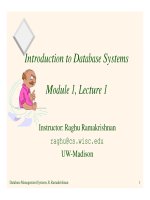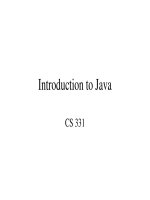introduction to scala lecture
Bạn đang xem bản rút gọn của tài liệu. Xem và tải ngay bản đầy đủ của tài liệu tại đây (357.46 KB, 33 trang )
Introduction to Scala
Introduction to Scala
Lecture
Lecture
CMSC 331
SD Vick
2
2
What’s Scala and why should You
What’s Scala and why should You
Care?
Care?
•
It’s language written by by Martin Odersky at
It’s language written by by Martin Odersky at
EPFL
EPFL (École Polytechnique Fédérale de Lausanne
(EPFL), Lausanne, Switzerland
•
Influenced by ML/Haskell, Java and other
languages
•
with better support for component software
with better support for component software
•
It’s a scalable Programming language for
It’s a scalable Programming language for
component software with a focus is on
component software with a focus is on
abstraction
abstraction
,
,
composition
composition
, and
, and
decomposition and
decomposition and
not on primitives
not on primitives
•
It
It
unifies OOP and functional programming
unifies OOP and functional programming
•
It interoperates with Java and .NET
It interoperates with Java and .NET
3
3
Why Scala?
Why Scala?
(Coming from Java/C++)
(Coming from Java/C++)
•
Runs on the JVM
–
Can use any Java code in Scala
–
Almost as fast as Java (within 10%)
•
Much shorter code
–
Odersky reports 50% reduction in most code over Java
–
Local type inference
•
Fewer errors
– No Null Pointer problems
• More flexibility
– As many public classes per source file as you want
– Operator overloading
4
4
Getting Started in Scala
Getting Started in Scala
•
scala
–
Runs compiled scala code
–
Or without arguments, as an interpreter!
• scalac - compiles
• fsc - compiles faster! (uses a background server to
minimize startup time)
•
Go to scala-lang.org for downloads/documentation
•
Read Scala: A Scalable Language
(see
/>e.html
)
5
5
Features of Scala
Features of Scala
• Scala is both functional and object-oriented
– every value is an object
– every function is a value including methods
•
Scala is statically typed
–
includes a local type inference system:
–
in
in
Java 1.5:
Java 1.5:
Pair<Integer, String> p =
Pair<Integer, String> p =
new Pair<Integer, String>(1, "Scala");
new Pair<Integer, String>(1, "Scala");
–
in
in
Scala:
Scala:
val p = new MyPair(1, "scala");
val p = new MyPair(1, "scala");
6
6
Scala – The Interpreter
Scala – The Interpreter
•
Easiest way to get started with Scala is by using the Scala interpreter, which
is an interactive “shell” for writing Scala expressions
• Simply type an expression into the interpreter and it will evaluate the
expression and print the resulting value.
$ scala
This is an interpreter for Scala. Type in expressions to have them evaluated.
Type :help for more information. scala> After you type an expression, such
as 1 + 2, and hit return:
scala> 1 + 2
•
The interpreter will print:
unnamed0: Int = 3
•
This line includes: an automatically assigned or user-defined name to refer to
the computed value (unnamed0) a colon (:) the type of the expression and
its resulting value (Int) an equals sign (=) the value resulting from evaluating
the expression (3)
7
7
More features
More features
•
Supports lightweight syntax for anonymous
functions, higher-order functions, nested
functions, currying
• ML-style pattern matching
•
Integration with XML
– can write XML directly in Scala program
– can convert XML DTD into Scala class definitions
•
Support for regular expression patterns
8
8
Other features
Other features
•
Allows defining new control
structures without using macros,
and while maintaining static typing
•
Any function can be used as an infix
or postfix operator
•
Can define methods named +, <=
or ::
9
9
Automatic Closure Construction
Automatic Closure Construction
•
Allows programmers to make their own
control structures
•
Can tag the parameters of methods
with the modifier def.
•
When method is called, the actual def
parameters are not evaluated and a no-
argument function is passed
10
10
object TargetTest1 with Application {
def loopWhile(def cond: Boolean)(def body: Unit): Unit =
if (cond) {
body;
loopWhile(cond)(body);
}
var i = 10;
loopWhile (i > 0) {
Console.println(i);
i = i – 1
Note: var/val
Note: var/val
}
}
While loop example
While loop example
Define loopWhile method
Use it with nice syntax
Scala class hierarchy
Scala class hierarchy
12
12
Scala object system
Scala object system
•
Class-based
•
Single inheritance
•
Can define singleton objects easily
(no need for static which is not really
OO)
•
Traits, compound types, and views
allow for more flexibility
13
13
Basic Scala
Basic Scala
•
Use var to declare variables:
var x = 3;
x += 4;
• Use val to declare values (final vars)
val y = 3;
y += 4; // error
• Notice no types, but it is statically typed
var x = 3;
x = “hello world”; // error
•
Type annotations:
var x : Int = 3;
14
14
Basic Scala
Basic Scala
•
Class instances
val c = new IntCounter[String];
• Accessing members
(Look Ma no args!)
println(c.size); // same as c.size()
•
Defining functions:
def foo(x : Int) { println(x == 42); }
def bar(y : Int): Int = y + 42; // no braces
// needed!
def return42 = 42; // No parameters either!
15
15
Functions, Mapping, Filtering
Functions, Mapping, Filtering
•
Defining lambdas – nameless functions (types
sometimes needed)
val f = x :Int => x + 42;
f is now a
f is now a
mapping int-> int
mapping int-> int
•
Closures!
A way to haul around state
A way to haul around state
var y = 3;
val g = {x : Int => y += 1; x+y; }
•
Maps (and a cool way to do some functions)
List(1,2,3).map(_+10).foreach(println)
•
Filtering (and ranges!)
1 to 100 filter (_ % 7 == 3) foreach (println)
–
(Feels a bit like doing unix pipes?)
16
16
Classes and Objects
Classes and Objects
trait Nat;
object Zero extends Nat {
def isZero: boolean = true;
def pred: Nat =
throw new Error("Zero.pred");
}
class Succ(n: Nat) extends Nat {
def isZero: boolean = false;
def pred: Nat = n;
}
17
17
Traits
Traits
•
Similar to interfaces in Java
•
They may have implementations of
methods
•
But can’t contain state
•
Can be multiply inherited from
More on Traits
More on Traits
•
Halfway between an interface and a class,
called a
trait
.
•
A class can incorporate as multiple Traits like
Java interfaces but unlike interfaces they can
also contain behavior, like classes.
•
Also, like both classes and interfaces, traits
can introduce new methods.
•
Unlike either, the definition of that behavior
isn't checked until the trait is actually
incorporated as part of a class.
19
19
Example of traits
Example of traits
trait Similarity {
def isSimilar(x: Any): Boolean;
def isNotSimilar(x: Any): Boolean = !isSimilar(x);
}
class Point(xc: Int, yc: Int) with Similarity {
var x: Int = xc;
var y: Int = yc;
def isSimilar(obj: Any) =
obj.isInstanceOf[Point] &&
obj.asInstanceOf[Point].x == x;
}
20
20
Mixin class composition
Mixin class composition
• Basic inheritance model is single inheritance
• But mixin classes allow more flexibility
class Point2D(xc: Int, yc: Int) {
val x = xc;
val y = yc;
// methods for manipulating Point2Ds
}
class ColoredPoint2D(u: Int, v: Int, c: String)
extends Point2D(u, v) {
var color = c;
def setColor(newCol: String): Unit = color =
newCol;
}
Mixin class composition example
Mixin class composition example
class Point3D(xc: Int, yc: Int, zc:
Int)
extends Point2D(xc, yc) {
val z = zc;
// code for manipulating Point3Ds
}
class ColoredPoint3D(xc: Int, yc: Int, zc: Int, col: String)
extends Point3D(xc, yc, zc)
with ColoredPoint2D(xc, yc, col);
ColoredPoint2D
Point2D
Point3D
ColoredPoint3D
ColoredPoint2D
22
22
Mixin class composition
Mixin class composition
•
Mixin composition adds members
explicitly defined in ColoredPoint2D
(members that weren’t inherited)
•
Mixing a class C into another class D is
legal only as long as D’s superclass is a
subclass of C’s superclass.
– i.e., D must inherit at least everything that
C inherited
•
Why?
23
23
Mixin class composition
Mixin class composition
•
Remember that only members explicitly
defined in ColoredPoint2D are mixin inherited
• So, if those members refer to definitions
that were inherited from Point2D, they had
better exist in ColoredPoint3D
–
They do, since
ColoredPoint3D extends Point3D
which extends Point2D
24
24
Views
Views
•
Defines a
coercion
from one type to another
•
Similar to conversion operators in C++/C#
trait Set {
trait Set {
def include(x: int): Set;
def include(x: int): Set;
def contains(x: int): boolean
def contains(x: int): boolean
}
}
def view(list: List) : Set = new Set {
def view(list: List) : Set = new Set {
def include(x: int): Set = x prepend xs;
def include(x: int): Set = x prepend xs;
def contains(x: int): boolean =
def contains(x: int): boolean =
!isEmpty &&
!isEmpty &&
(list.head == x || list.tail contains x)
(list.head == x || list.tail contains x)
}
}
Views
Views
•
Views are inserted automatically by the Scala
compiler
•
If
e
is of type
T
then a view is applied to
e
if:
–
expected type of
e
is not
T
(or a supertype)
–
a member selected from
e
is not a member of
T
•
Compiler uses only views in scope
Suppose xs : List and view above is in scope
val s: Set = xs;
val s: Set = xs;
xs contains x
xs contains x
val s: Set =
val s: Set =
view
view
(xs);
(xs);
view
view
(xs)
(xs)
contains x
contains x









